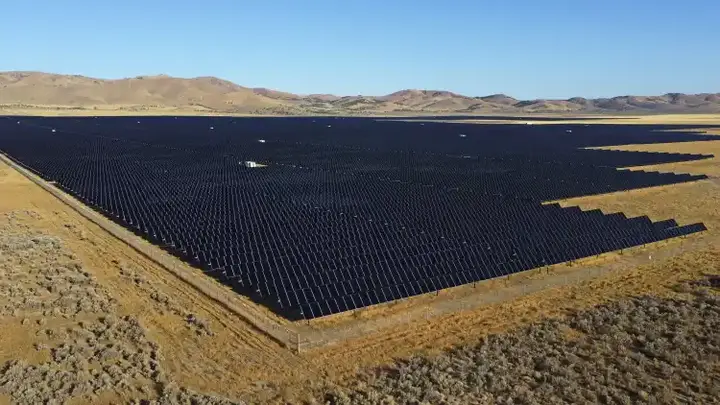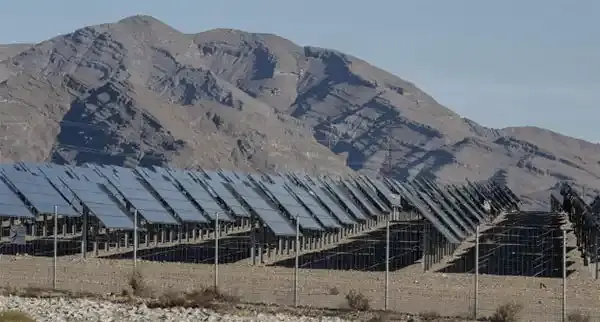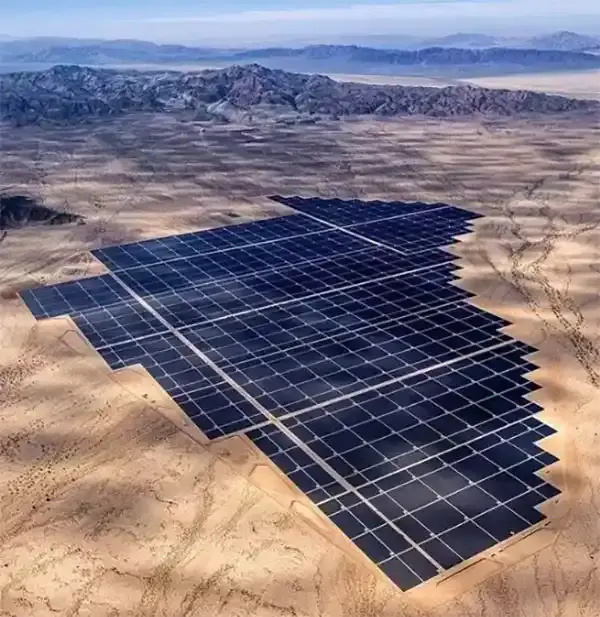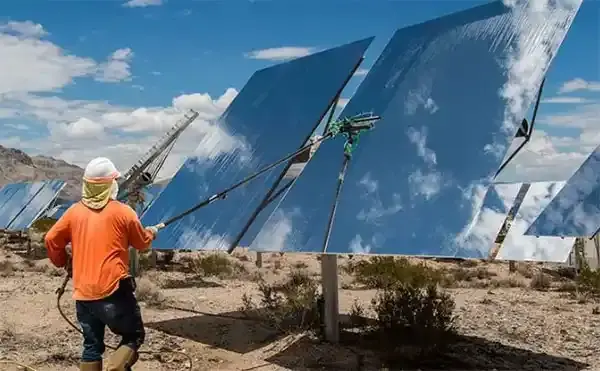Solar panels in the Sahara desert could boost renewable energy but harm global climate

The world's harshest deserts may be the best places on earth to harvest solar energy – the most abundant and cleanest source of energy we have. Deserts are wide, relatively flat, and rich in silicon – the raw material from which the semiconductors from which solar cells are made – never lack sunlight. Indeed, the ten largest solar power plants around the world are all located in deserts or dry areas.
Show key points
- Deserts, with their vast, sun-drenched and silicon-rich landscapes, are ideal locations for harvesting solar energy.
- Transforming the Sahara into a massive solar farm has the theoretical potential to generate four times the current global energy demand.
- Although solar panels absorb large amounts of sunlight, only about 15% is converted into electricity, with the rest turning into heat that can alter local climates.
- ADVERTISEMENT
- Large-scale solar farms reduce surface reflectivity, triggering feedback loops that could increase desert rainfall and allow vegetation to spread.
- Historical evidence from the African wet period suggests that such environmental changes could potentially re-green the Sahara.
- However, climate models indicate that large solar farms may cause global climate disruptions, including droughts in the Amazon and intensified storms in other regions.
- The long-term impacts of desert solar farms are complex and interconnected, stressing the need for comprehensive Earth system modeling before large-scale implementation.
The researchers imagine that it may be possible to transform the world's largest desert, the Sahara, into a giant solar farm, capable of meeting four times the current global energy demand. Plans have been drawn up for projects in Tunisia and Morocco that will provide millions of households in Europe with electricity. While the black roofs of solar panels absorb most of the sunlight that reaches them, only a fraction (about 15%) of that incoming energy is converted into electricity. The rest returns to the environment in the form of heat. The panels are usually much darker than the ground they cover, so a large area of solar cells will absorb a great deal of extra energy and emit it in the form of heat, which affects the climate.
Recommend
Greener desert

A 2018 study used a climate model to simulate the effects of low whiteness on the earth's surface in deserts due to the installation of large solar farms. Whiteness is a measure of how well surfaces can reflect sunlight. For example, sand is more reflective than solar panels and therefore has a higher whiteness. The model revealed that when a solar farm reaches 20% of the total area of the desert, it leads to a feedback loop. The heat emitted by dark solar panels (compared to highly reflective desert soils) creates a sharp temperature difference between the land and the surrounding oceans which ultimately lowers surface air pressure and causes humid air to rise and condense in raindrops. As monsoon rainfall increases, plants grow and the desert reflects less sun energy, as plants absorb light better than sand and soil. As there are more plants, more water evaporates, creating a wetter environment that causes the plants to spread.
This scenario may seem fanciful, but studies show that a similar feedback loop kept much of the Sahara desert green during the African wetness period, which ended only 5,000 years ago. So, a giant solar farm can generate abundant energy to meet global demand and at the same time transform one of the most hostile environments on earth into a habitable oasis. Sounds perfect, doesn't it? Not quite. In a recent study, we used an advanced Earth system model to examine how desert solar farms interact closely with the climate. Our model takes into account the complex reactions between the interacting spheres of the world's climate - the atmosphere, ocean, land and its ecosystems. It showed that there may be unintended impacts in remote parts of land and ocean that offset any territorial benefits to the Sahara itself.
Drought in the Amazon and hurricanes in Vietnam

Covering 20% of the Sahara with solar farms raises local temperatures in the desert by 1.5°C according to our model. At 50% coverage, the temperature increase is 2.5°C. This warming is eventually spread around the world by atmospheric and ocean movement, raising the global average temperature by 0.16°C to cover 20%, and 0.39°C to cover 50%. However, the shift in global temperatures is not uniform – polar regions will warm more than the tropics, increasing the loss of Arctic sea ice. This could accelerate warming, as melting sea ice reveals dark water that absorbs more solar energy. This massive new source of heat in the Sahara Desert is reorganizing air circulation and the global ocean, affecting rainfall patterns around the world.

The narrow range of heavy rainfall in the tropics, which accounts for more than 30% of global rainfall and supports the rainforests of the Amazon basin and Congo, is shifting north in our simulations. For the Amazon, this causes drought with less moisture arriving from the ocean. Almost the same amount of extra rain falling on the Sahara Desert due to the effects of solar panels on surface blackout is lost from the Amazon. The model also predicts more tropical cyclones hitting the coasts of North America and East Asia. Some important processes are still missing from our model, such as dust emitted by large deserts. Desert dust, carried by the wind, is a vital source of nutrients for the Amazon and the Atlantic Ocean. So a greener desert may have a greater global impact than our simulations suggested. We are just beginning to understand the potential consequences of creating huge solar farms in the deserts of the world. Solutions like these may help society shift away from fossil energy, but Earth system studies like ours underscore the importance of considering the many interrelated responses to the atmosphere, oceans, and Earth's surface when examining their benefits and risks.
![]()
The best economical graphics cards for gaming and content creation - available in the Arab world
Looking for strong gaming and content creation performance on a budget? The NVIDIA GeForce GTX 1660 Super and RTX 3050 stand out for 1080p, while the AMD RX 6700 XT and NVIDIA RTX 3060 Ti shine at 1440p. Great value options packed with smooth performance and essential features like ray tracing. more- ADVERTISEMENT
![]()
The world of Arab game developers - independent and unknown successes
Arab games developers - Unknown independent Successes more- ADVERTISEMENT
![]()
7 physical cues that can help you read someone like an open book
Body language reveals more than words—handshakes, smiles, and even foot movements hint at confidence, stress, or honesty. A dominant handshake may suggest control; sincere smiles reach the eyes; fidgeting signals anxiety. Pay attention to these subtle cues, but always consider context—it's the key to truly understanding someone. more- ADVERTISEMENT
![]()
Can you get into Svalbard's seed vault?
Tucked inside a remote Arctic mountain, the Svalbard Global Seed Vault stores over 930,000 crop varieties as a backup for global food security. It's a quiet champion, preserving biodiversity and standing ready when disaster or conflict strikes, like it did for Syria’s lost gene bank. more- ADVERTISEMENT
![]()
Is time travel possible? Astrophysicist explains the science behind science fiction
Time travel fascinates us, but science says it’s not so easy. While Einstein’s theory shows time moves differently at high speeds—like for astronauts—true time travel still faces big hurdles. Wormholes, paradoxes, and the laws of physics keep it in the realm of imagination, at least for now. more- ADVERTISEMENT
![]()
The most important technical programs for mobile and computer that are indispensable for everyone
Mobile phones and computers are essential in modern life, and with the right free tools, they can boost your productivity and simplify daily tasks. Apps like Google Chrome, Google Drive, LibreOffice, and VLC Media Player are easy to use and help you stay efficient, secure, and entertained. more- ADVERTISEMENT
![]()
5 habits to save on your monthly allowance
5 habits to save on your monthly expenses more- ADVERTISEMENT
![]()
Things people with emotional intelligence never do
Emotional intelligence helps people understand and manage emotions, leading to better relationships, improved teamwork, and stronger mental health. It can be developed through self-reflection, mindfulness, and active listening. Emotionally intelligent people avoid impulsive actions and build balanced lives with better decision-making and communication. more- ADVERTISEMENT
![]()
How to price your product? Best Pricing Strategies
Finding the right price for your product is key to profit and customer satisfaction. Try different strategies—like cost-based, value-based, or psychological pricing—and stay flexible. There's no one-size-fits-all method, but aligning your price with customer needs and market factors is the smart move. more- ADVERTISEMENT
![]()
The history of the city of Samarra ... Iraq's Hidden Gem
Samarra, once a grand Abbasid capital, still stands with its iconic spiral minaret and rich Shia heritage. Though chosen as the capital of Islamic civilization in 2020, the city remains dusty and neglected, holding untold stories within its historic ruins. more- ADVERTISEMENT





















